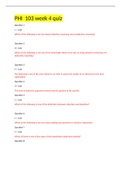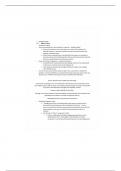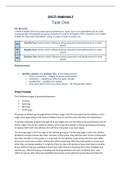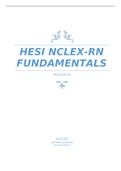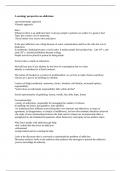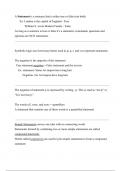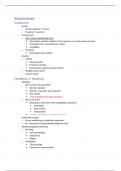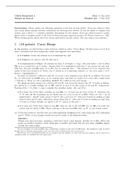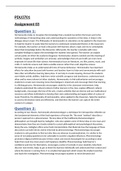THINK ABOUT THE WORLD
SU 2.1. SCHEMAS: MENTAL FRAMEWORKS FOR
ORGANISING – AND USING – SOCIAL INFORMATION
Schemas: Mental frameworks centering on a specific theme that help us to organize
social information.
THE IMPACT OF SCHEMAS ON SOCIAL COGNITION:
ATTENTION, ENCODING, RETRIEVAL
Schemas influence attention (the information we notice, for which schemas act as filters),
encoding (the process by which information gets stored in memory), and retrieval.
Information inconsistent with schemas is more likely to be noticed and to enter our
consciousness.
We rely most on schemas when we are experiencing cognitive load (a lot of information
at once).
Information that is consistent with our schemas is encoded. Information that is sharply
inconsistent with our schemas may be encoded into a separate memory location and
marked with a unique “tag”.
Regarding memory: In general, people report remembering more information consistent
with their schemas, but information inconsistent with their schemas may be strongly
present in memory too.
PRIMING: WHICH SCHEMAS GUIDE OUR THOUGHT?
Priming: a situation that occurs when stimuli or events increase the availability in
memory or consciousness of specific types of information held in memory. Schemas can
be temporarily activated by priming.
Unpriming: Refers to the fact that the effects of the schemas tend to persist until they
are somehow expressed in thought or behaviour and only then do their effects decrease.
If primed schemas are not expressed, their effects may persist for long periods of time.
The stronger and better-developed our schemas are, the more likely they are to influence
our thinking, and especially our memory for social information.
SCHEMA PERSISTENCE: WHY EVEN DISCREDITED SCHEMAS
CAN SOMETIMES INFLUENCE OUR THOUGHT BEHAVIOUR
Perseverance effect: The tendency for beliefs and schemas to remain unchanged even
in the face of contradictory information.
Evidence suggests that schemas can be self-fulfilling – they both shape and reflect the
social world.
, Schemas help us make sense of the social world and process information efficiently, but
they can also lock us into acting in ways that create the world we expect.
REASONING BY METAPHOR: HOW SOCIAL ATTITUDES AND
BEHAVIOUR ARE AFFECTED BY FIGURES OF SPEECH
Metaphor: A linguistic device that relates or draws a comparison between one abstract
thought and another dissimilar concept.
Because metaphors can activate different kinds of social knowledge, they can influence
how we interpret events.
SU 2.2. HEURISTICS: HOW WE REDUCE OUR EFFORT IN
SOCIAL COGNITION
Social cognition: The manner in which we interpret, analyse, remember, and use
information about the social world.
Heuristics: Simple rules for making complex decisions or drawing inferences in a rapid
and seemingly effortless manner.
Affect: our current feelings and moods.
When we are subjected to more information than what we are capable of processing at
one time, this results in information overload.
Processing capacity can be diminished by stress levels.
We rely on heuristics because they allow us to do more, with less effort.
REPRESENTATIVENESS: JUDGING BY RESEMBLANCE
Prototype: Summary of the common attributes possessed by members of a category.
Representativeness heuristic: A strategy for making judgements based on the extent to
which current stimuli or events resemble other stimuli or categories.
Decisions based on the representative heuristic can be wrong, because they tend to
ignore base rates.
Base rates: the frequency with which given events or patterns occur in the total
population.
Cultural groups differ in the extent to which they rely on the representative heuristic and
expect “like to go with like” in terms of causes and effects.
Compared to North Americans, Asians rely less on the representative heuristic.
AVAILABILITY: “IF I CAN RETRIEVE INSTANCES, THEY MUST
BE FREQUENT”
Availability heuristic: A strategy for making judgments on the basis of how easily
specific kinds of information can be brought to mind.
, Use of availability heuristic can cause us to overestimate the likelihood of events that are
dramatic but rare because they are easy to bring to mind.
When using the availability heuristic, the amount of information we can recall is also
influential.
If the judgement involves emotions or feelings, we tend to rely on the “ease” rule,
whereas if the judgement involves facts or if the task is inherently difficult, we tend to
rely more on the “amount” rule.
ANCHORING AND ADJUSTMENT: WHERE YOU BEGIN MAKES
A DIFFERENCE
Anchoring and adjustment heuristic: A heuristic that involves the tendency to use a
number, value, or personal experience as a starting point to which we then make
adjustments. An example is when a seller sets the price higher than he expects to get, and
a buyer bids lower than he is willing to pay.
We have a tendency to let initial anchors influence our judgements.
Although we make adjustments to anchors, these adjustments are often not sufficient to
overcome the initial impact of the anchors.
The tendency to make insufficient judgements is greater when people are in a state in
which they are less capable of engaging in effortful thought.
STATUS QUO HEURISTIC: “WHAT IS, IS GOOD”
When people are asked to make judgements and choices, they seem to act as though they
believe the status quo is good. For example, the brand that has been on the market
longer is better than the newer brand.
SU 2.3. AUTOMATIC AND CONTROLLED PROCESSING:
TWO BASIC MODES OF THOUGHT
Social thought can occur in either of two different ways: in a systematic, logical, and
highly effortful manner (controlled processing), or in a fast, relatively effortless, and
intuitive manner (automatic processing). Both may occur together.
Research suggests that people have two different neural systems for processing social
information – one that operates in an automatic manner, and one that operates in a
systematic and controlled manner.
AUTOMATIC PROCESSING AND AUTOMATIC SOCIAL
BEHAVIOUR
Automatic processing: This occurs when, after extensive experience with a task or type
of information, we reach the stage where we can perform the task or process the
information in a seemingly effortless, automatic, and nonconscious manner.
, Research also shows that once automatic processing is initiated (e.g. through priming),
individuals may – unconsciously – begin to prepare for future interactions with the
people or groups who are the focus of this automatic processing.
THE BENEFITS OF AUTOMATIC PROCESSING: BEYOND MERE
EFFICIENCY
Research shows that we often attempt to deal with problems, and even complex
decisions, while our attention is directed elsewhere.
Recent research suggests that automatic processing may even be superior to conscious
thought when it comes to making good decisions.
Automatic thought has greater capacity, and may also reflect our real preferences more
clearly.
SU 2.4. POTENTIAL SOURCES OF ERROR IN SOCIAL
COGNITION: WHY TOTAL RATIONALITY IS RARER
THAN YOU THINK
A BASIC “TILT” IN SOCIAL THOUGHT: OUR POWERFUL
TENDENCY TO BE OVERLY OPTIMISTIC
Optimistic bias: Our predisposition to expect things to turn out well overall.
Negativity bias: We show greater sensitivity to negative information than to positive
information. The negativity bias is not universal, and may be eliminated if we find
ourselves in situations in which paying attention to positive information is useful.
Overconfidence barrier: The tendency to have more confidence in the accuracy of our
own judgements than is reasonable.
Most people believe they are more likely than others to experience positive events, and
less likely to experience negative events.
People who are least competent in a domain are often most likely to be overconfident of
their judgements in that domain.
Overconfidence often stems from errors of omission. We lack the relevant feedback that
would help moderate our confidence.
THE ROCKY PAST VERSUS THE GOLDEN FUTURE: OPTIMISM AT
WORK
We tend to think our future will be happy and ‘golden’, with few negative events.
When we think about the past, we tend to remember failures and unpleasant events.
When we think about the future, we focus on our dreams and plans.
Being optimistic about the future can make us feel good. If the basis for it is
disconfirmed, we may feel bad – but only temporarily.

